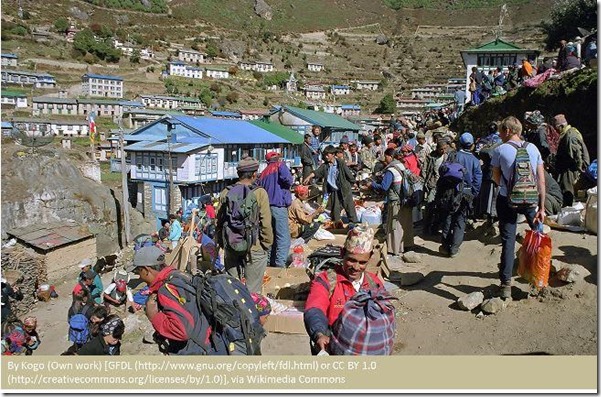As authorities and developers work hard to help families somehow struggle through the devastating results of the 7.8 magnitude earthquake of April 25 and the second major earthquake of May 12, my thoughts turn to the longer term benefit to be had, in promoting the development of financial services that will help recovery over the next 5 years.
Mobile money clearly has a key role to play in this breathtakingly beautiful country, to help to empower the population in a variety of different ways. Thanks for joining me in reflecting on this, as I share some of our findings from our recent report “Digital Money in Nepal 2014”.
A clear need
The biggest driver of digital money in Nepal is the need for financial inclusion. Of the population of 28.9 million, only around 33.5% are banked, but there are over 18m mobile subscriptions. Mobile phones are therefore a good way to reach people with financial services, with Internet penetration only an estimated 28.9%.
Moving from cash to non-cash, appropriate electronic payments can reduce the cost whilst allowing outreach to poor and remote people in a manner never possible before. But the rate of adoption greatly depends on the actions of government, commercial and development entities in moving payments to the new instruments.
While the Kathmandu area is a hotspot for banking, the concern has been to reach areas outside the valley. While Nepal Rastra Bank (NRB) has set up branch opening policies to promote this (1 branch in Kathmandu after 3 outside the valley), the challenge is to create economically viable, alternate and appropriate services.
Regulations and the challenge of Shadow Banking
In December 2012 NRB issued a circular to allow branchless banking agents and direct how internet- and mobile-based services like branchless banking, mobile banking, internet banking and card services offered by banks and financial institutions (BFIs) must obtain approval.
Where there are needs, services rise up to meet them. NRB is concerned about the rise of shadow banking in the form of unlicensed and unregulated cooperatives and Dhukuti and Hundi services, but in the absence of alternatives, these informal activities play a key role in servicing needs.
Card services are still relatively new, and branches and ATMs are simply not sufficient to reach into the remote areas of the country. Banks in Nepal began to offer online banking and mobile banking for over 10 years now. However while the Class A banks (around 30 in Nepal) were first to launch services, the Development banks (around 90, with an additional 21 Micro Finance banks) and NGOs (around 40) will play a critical role in taking the services in the appropriate manner to where they are needed most.
New mobile wallet and mobile money services are being launched and their success will depend on the partnerships forged, and the extent to which this results in new value-added services.
Why Branchless Banking?
Given the historical and geographical challenges, the share of the population living below the poverty line is still as high as 31.5%, though this has fallen recently driven by the flow of remittances into the country.
Branchless Banking can play a vital role in building a country asset from the vibrant informal economy. Remittance income from the 2 million Nepalese diaspora is crucial for the country, and constitutes an estimated 17.3% of gross domestic product. As money goes digital, more of the informal economy gets reflected on the balance sheet of the country. With an annual remittance inflow of over $14 billion from the 2 million diaspora, it is expected that as much as 90% of remittances may well be informal.
If formal remittances increase, it is a win-win for consumers who get the safety and convenience of receiving money directly into their BB accounts, and the government who see more of the money on the books. Again, as Government disbursements turn digital, much of the spending gets accounted for, driving investments as providers see the hope of viable markets.
The story so far
In June 2012 Laxmi Bank launched Hello Paisa in Kavre and Sindhupalchowk. Hello Paisa provided by Finaccess, is a shared and interoperable managed service provided to BFIs. It uses IVR and SMS to allow money transactions using smartphones. The Hello Paisa network has over seven BFI partners. In 2013 the Prabhu Group network, consisting of more than 3,500 money transfer agents and 1,500 cooperatives nationwide entered an agreement with them to provide end-to-end mobile financial services (MFS) offered by the Hello Paisa Network.
Digital networks indeed play a key role in disbursements, as do the various mobile banking and mobile wallet services, including 14 key services that had launched by the time of our study.
Where next?
Today as people around the world are in solidarity with folks in Nepal, this is an inflection point for the country.
I believe change of the right kind can and should happen, and decisions taken in the next months will critically contribution to this.



I will surely be able to .stop going to banks so often. Nice.